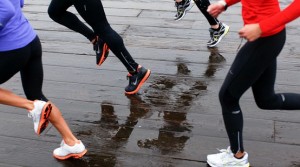You’ve already read Running For Beginners: The Right First Steps so you know way more than I did when I first started running. You have the right shoes, fit to you specifically for your Biomechanical needs, the right socks, a running buddy and a goal.
Now that you have all the confidence in the world, let’s crush it! Just kidding…but really, the first runs can be quite humbling/heartbreaking, especially for those who used to run and ran quite well. It takes time and patience and consistency to be able to run so take note of your accomplishments along the way and don’t get discouraged. You will get there. I promise. If you follow the steps below, your run will be motivating instead of demotivating.
Your first run is a chance to test the waters, test out your new shoes and to see what your starting point is. You will see great improvements in your fitness over the first few weeks of running and it will boost your confidence. I recommend getting a note book or training journal/log to track your workouts and see improvements. Anything will work for this purpose. You could even start a training blog and all your friends can read about your progress. The log I like to use is part of the the Nike + Sportband system. This watch is really affordable, tracks my distance pace and time, and after every run I plug it into my computer and it keeps track of everything! I don’t have to write anything down!

Hopefully by now you have picked a training plan. If not, here are a couple to consider:
1. For your first run, pick something flat. In the Salt Lake area I recommend Liberty Park, Sugarhouse Park (not totally flat), the Jordan River Parkway, or Wasatch Boulevard. There are many more places to run, but these will help you get started. Make sure you are smart and don’t go to bad areas where it is unsafe. Always tell someone where you are going, and wear the right colors for the lighting you will be running in. Reflective gear is necessary in the late Summer through late Winter because most people end up running when it is dark outside.
2. Warm up! I can’t stress the importance of a warm up. A lot of beginners think a warm up will shorten their workout. This is not the case, a good warm up will help get your body in the groove and will also help prevent injuries. You will get more out of a work out because you took time to prepare your body for exercise. Start with some running drills like high knee jumps, butt kicks, grape-vine walks or jumping jacks…something to get lose.
3. Next, do some light stretching. It is important to only stretch after you have warmed up your muscles a tad. Static stretches on cold muscles have the potential to do damage to the muscle tissue.
4. Begin slowly jogging. You should be able to keep a conversation with someone with ease. If you can’t talk, slow down.
5. Try not to over think the run. Just go with what feels natural. Don’t get overly obsessed with your pace, form or heart-rate, just run. You will get to the point where you will think about these things, but we aren’t there right now. Just get used to the movement of running. The next “Running for Beginners” blog post will be about good running form, and until next week, focus on having fun and putting one foot in front of the other.
6. Don’t run “miles” when starting out. Instead, go for a set amount of time. If you have to do a run-walk -run-walk routine, that is just fine. Do whatever feels comfortable. As you get used to running for longer, add more minutes to the “run” part but don’t take minutes off the warm-up and cool-down.
7. The human body has an incredible ability to adapt. Push yourself when you think you can, and give yourself a break when you need it. Allow your body to show you what it can do.
8. Cool-down. This is a very important part of exercise to help prevent injuries and to increase your fitness. Cool-downs are designed to ease your body back to a resting heart rate. Either jog slowly or walk until your heart rate and breathing slows down to what it was when you started your run, or close to it. do.
9. STRETCH! This is also a VERY important part of running. Failure to stretch can cause all sorts of unwanted issues. Stretch your leg muscles really well including calves, Achilles tendons, quads and hamstrings. I would also recommend a foam roller. If you are unaware of what a foam roller is, come to one of our Foam Rolling and Injury Prevention Clinics! There are also great videos on YouTube that will help you figure out foam rolling. Here are some good ones.
The guy in this video has a great accent 🙂
This guy has a great accent too!
You probably are wondering about nutrition, hydration, recovery and all that fancy stuff. For your first few runs, don’t worry about this stuff too much. You know what is healthy to eat. You know water is going to hydrate you. Hydrate well before you run so you will not need it on your run. Always drink water and eat when you are done with a run to replenish what you’ve burned and sweated out. Further posts will include more info on these topics, so stay tuned.
Also, for an excellent opportunity to learn about proper nutrition for athletes, check out our upcoming Nutrition Seminar with Debbie Perry. These clinics are AMAZING and you will leave feeling motivated to eat right and take care of your body. Debbie will arm you with all the knowledge you need to be your very best self.
So there you have it. Go for a run and let us know how it goes. If you have questions, feel free to comment on this blog and they will get answered! The more questions we get, the better we can tailor our blog posts to your needs. Happy running!!!
More blogs on Getting Ready
More blogs on Your First Few Runs
